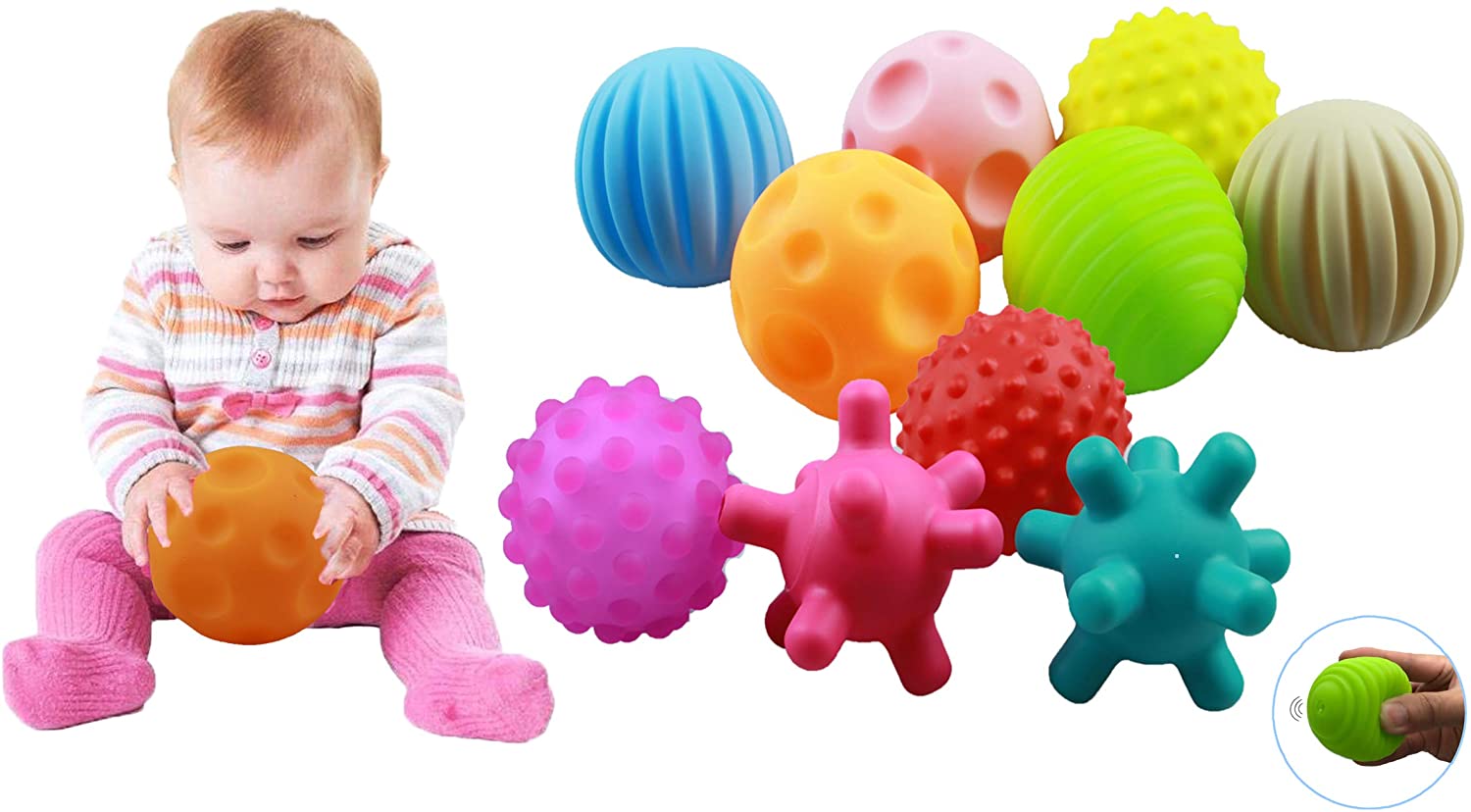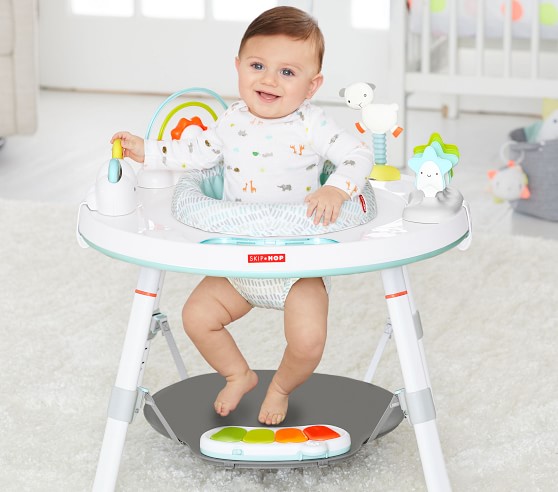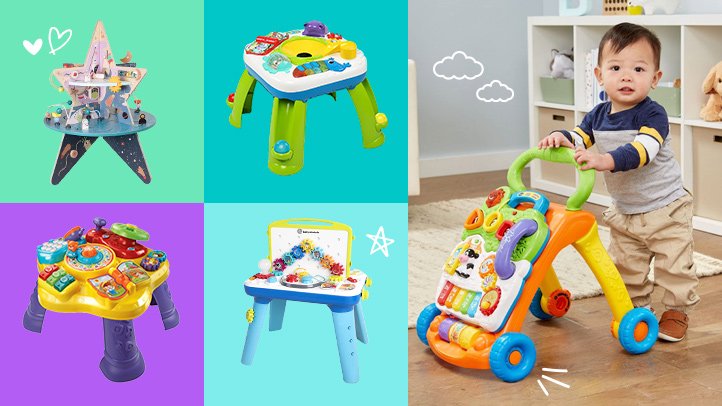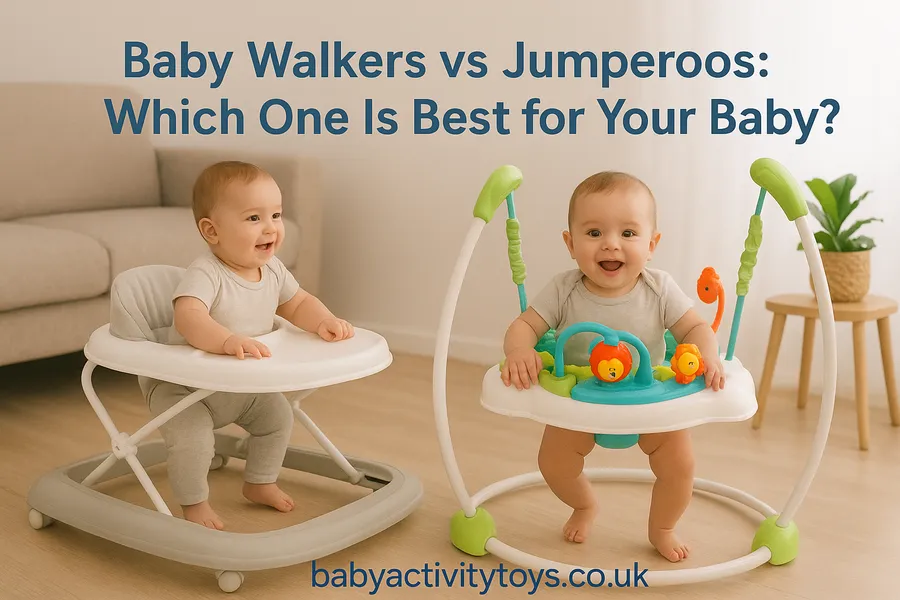
Why Sensory Play is Key to Baby’s Development: Tools to Encourage Exploration
As a parent, you’ve probably noticed how curious your baby is about the world around them. Every new texture, sound, or movement seems to captivate their attention, and for good reason—these sensory experiences are essential for their development. From the moment your baby is born, their senses are their main tools for interacting with and understanding the world. This is why sensory play is such a vital part of early childhood development.
You may have heard about the importance of motor skills and cognitive growth, but did you know that sensory play directly supports these areas? By engaging your baby’s senses—through touch, sight, hearing, smell, and even taste—you’re helping them build crucial brain connections and improve their motor skills, all while having fun.
This article explores the many benefits of sensory play, why it’s so important for your baby’s development, and how you can create a sensory-rich environment at home. We’ll also discuss how baby activity centres, with their multi-sensory elements, offer a perfect platform for encouraging your baby to explore the world around them while supporting their growth.
What is Sensory Play and Why Does it Matter?
Sensory play refers to any activity that stimulates your baby’s senses. It could be something as simple as feeling the texture of a soft blanket, listening to the rustling sound of a toy, or watching bubbles float in the air. Babies naturally engage in sensory play from the moment they start exploring their environment. As a parent, your role is to provide opportunities for this exploration in ways that will nurture their growing minds and bodies.
But what makes sensory play so important?
When your baby engages with sensory materials—like touching something rough or soft—they’re not just learning about the object itself; they’re also strengthening their cognitive, motor, and emotional skills. Through sensory play, your baby begins to understand the world by forming connections between what they see, hear, and touch, and the movements they need to interact with those objects.

How Sensory Play Builds Brain Connections
From birth to the age of two, your baby’s brain is growing rapidly, and sensory experiences play a huge role in this process. The more your baby interacts with different textures, sounds, and sights, the more connections are formed in their brain. These neural pathways will help them make sense of their environment, and over time, these experiences lay the foundation for future learning.
For example, when your baby touches a rough surface, their brain is processing information about texture, helping them to differentiate between rough and smooth. This might seem like a small, simple task, but these early experiences build the foundation for more complex thinking skills, like problem-solving and reasoning.
Sensory Play and Motor Skill Development
Motor skill development and sensory play go hand in hand. When babies engage their senses, they are also engaging their muscles. Reaching for a toy, turning it over, and feeling its texture helps babies develop both fine and gross motor skills. This connection between the senses and motor skills is vital, especially in the early months of life when your baby is learning to control their movements.
For example, a baby who grabs a soft ball is not only exploring its texture but also practicing their grasping skills. They learn how much pressure to apply, how to coordinate their hand movements with their eyes, and how to move the ball in different directions. Over time, these small movements add up to bigger milestones, such as crawling, walking, and eventually writing.
Emotional Benefits of Sensory Play
Sensory play isn’t just about physical and cognitive development—it’s also essential for emotional growth. When babies are given the chance to explore their environment in a safe, nurturing space, they develop confidence and independence. Sensory play encourages curiosity and problem-solving, allowing your baby to approach challenges with interest rather than frustration.
Additionally, sensory play can have a calming effect on babies. Engaging with soothing textures or listening to gentle sounds can help regulate your baby’s emotions and provide comfort, particularly in overstimulating environments. This is why activities like playing with water, sand, or soft fabrics are often recommended for babies who need a little extra soothing.
The Connection Between Sensory Play and Motor Skills
Now that you understand how sensory play impacts your baby’s brain development, let’s delve deeper into the connection between sensory experiences and motor skill growth. Babies learn best when they can move and explore, and sensory play is the perfect way to encourage this movement.
How Sensory Play Strengthens Fine Motor Skills
Fine motor skills involve the small muscles in your baby’s hands, fingers, and wrists. These skills are essential for everyday tasks, like picking up small objects, turning the pages of a book, or eventually holding a pencil. Sensory play is a natural way to strengthen these muscles.
When your baby manipulates sensory toys—like squeezing a soft toy, picking up small sensory balls, or running their hands through textured fabrics—they are working on their grip, coordination, and hand-eye coordination. Simple tasks like filling and dumping small objects or stacking soft blocks provide endless opportunities for fine motor practice.
Sensory Play and Gross Motor Skill Development
Gross motor skills, on the other hand, involve the larger muscles in your baby’s arms, legs, and torso. These skills help your baby roll over, crawl, walk, and eventually run. Sensory play is just as important for developing these larger muscles.
When your baby crawls towards a sensory toy, reaches for a hanging mobile, or pushes a sensory ball across the floor, they’re working on gross motor skills like balance, strength, and coordination. Activities that involve movement—such as crawling through a sensory tunnel or bouncing on a soft play mat—encourage your baby to engage their whole body, promoting gross motor development in a fun, playful way.
Setting Up a Sensory-Rich Environment at Home
Creating a sensory-rich environment for your baby doesn’t require a lot of expensive equipment or elaborate setups. With a few simple items and thoughtful planning, you can turn your home into a sensory playground that will encourage your baby to explore, move, and learn.
Start with the Basics: Textures, Sounds, and Visuals
The first step in setting up a sensory-rich environment is to think about the different senses you want to engage. Consider using a variety of textures, sounds, and visuals to stimulate your baby’s curiosity.
- Textures: Incorporate soft blankets, textured fabrics, and plush toys to stimulate your baby’s sense of touch. Try introducing different materials, like silk, cotton, or fleece, for your baby to explore. Activity mats with built-in sensory elements are a great way to offer a range of textures in one place.
- Sounds: Simple sounds, like the crinkle of a toy or the ringing of a bell, can captivate your baby’s attention. You can also include musical toys, rattles, or even soft background music to create an auditory-rich environment.
- Visuals: Babies are naturally drawn to high-contrast colours, especially in their early months. Black-and-white patterns, brightly coloured toys, and light-up elements can help stimulate your baby’s sense of sight. You can also hang colourful mobiles or soft mirrors to encourage your baby to track objects with their eyes.
Create Sensory Stations Around the Home
One effective way to keep your baby engaged in sensory play is by setting up different sensory stations around your home. These stations don’t need to be elaborate—just simple setups where your baby can explore different senses.
- Tummy Time Area: Set up a soft mat with a variety of sensory toys for tummy time. Include textured fabrics, soft toys, and a baby-safe mirror to encourage your baby to explore while lying on their tummy.
- Music Corner: Dedicate a corner of the room to musical play. Include soft rattles, bells, and toys that make gentle sounds when shaken or squeezed. Your baby can practice their motor skills by reaching for and interacting with these musical toys.
- Textured Play Zone: Use a soft play mat or a large blanket and scatter different textured toys and objects around the area. This could include soft blocks, plush animals, and fabric swatches. Encourage your baby to move around the space, feeling and exploring the different materials.
Rotate Sensory Toys to Maintain Interest
Babies can get bored quickly if they’re exposed to the same toys day after day. To keep your baby engaged, try rotating sensory toys in and out of their play area. This keeps things fresh and encourages your baby to explore new textures, sounds, and visuals.
For example, you might introduce a soft sensory ball one week and switch it out for a crinkly toy the next. This keeps your baby’s interest piqued and encourages them to practice different motor skills as they interact with new objects.
The Benefits of Baby Activity Centres for Sensory Play
If you’re looking for an all-in-one solution to encourage sensory play and motor skill development, baby activity centres are an excellent option. These multi-functional stations offer a range of sensory experiences, all within a safe, contained space. Let’s explore why baby activity centres are so effective in supporting your baby’s development.
Multi-Sensory Engagement
One of the greatest benefits of baby activity centres is that they engage multiple senses at once. Most centres feature a variety of textures, colours, and sounds to stimulate your baby’s senses. For example, you might find soft, crinkly fabrics, spinning toys that make noise, and bright colours all in one activity centre. This variety of sensory elements keeps your baby engaged and curious, encouraging them to explore the world around them while simultaneously developing their motor skills.
By reaching, grasping, and manipulating the different toys and textures on an activity centre, your baby will engage both their fine and gross motor skills. The crinkling fabric may prompt them to reach out, the spinning toy might encourage them to turn their wrist, and the dangling mirror could motivate them to lift their head or sit up to see their reflection. These multi-sensory elements help foster hand-eye coordination, balance, and body awareness, all crucial components of motor skill development.
Promoting Independent Play
Baby activity centres offer the perfect opportunity for your baby to engage in independent play. While babies love interaction with parents and caregivers, it’s equally important for them to learn to explore on their own. An activity centre provides a safe, contained environment where your baby can practice self-directed play. They’ll learn to make decisions—like which toy to grab first or which button to press—and this autonomy promotes cognitive growth and problem-solving skills.
As your baby becomes more familiar with their activity centre, they’ll also grow more confident in their abilities to explore it on their own. This builds emotional resilience and independence, as they learn to trust their instincts and enjoy the satisfaction of mastering new skills. Independent play is essential for your baby’s emotional and cognitive development, as it helps them feel capable and secure in their abilities.
Safe and Structured Exploration
One of the key benefits of a baby activity centre is that it offers a safe space for exploration. Unlike an open play area where hazards like sharp edges or small objects might pose risks, an activity centre is designed with safety in mind. Many activity centres are padded, stable, and built with non-toxic materials, so you can feel confident that your baby is playing in a secure environment.
Additionally, activity centres provide structure to your baby’s playtime. The toys and elements are typically arranged in a way that encourages movement and engagement, without overwhelming your baby with too many options. This structured environment allows your baby to focus on one activity at a time, helping them to develop concentration and attention skills. Over time, this focused play will improve their ability to engage in more complex activities as they grow.

Encouraging Sensory Play Throughout the Day
While baby activity centres are fantastic tools for sensory play, it’s also important to integrate sensory experiences into your baby’s daily routine in other ways. Sensory play doesn’t have to be a special, isolated activity—it can be part of everyday interactions and experiences.
Incorporate Sensory Play Into Tummy Time
Tummy time is crucial for your baby’s development, helping to strengthen their neck, shoulders, and core muscles. By adding sensory elements to tummy time, you can make this important activity even more engaging and beneficial. For example, place textured mats or soft toys within your baby’s reach, encouraging them to feel different materials while they push up on their arms. You could also place a baby-safe mirror in front of them, allowing them to explore their reflection while strengthening their muscles.
As your baby becomes more comfortable with tummy time, you can increase the level of challenge by placing sensory toys slightly out of their reach, motivating them to stretch, roll, or crawl towards the objects. This combination of sensory exploration and movement is perfect for building both motor skills and sensory awareness.
Include Sensory Elements During Bath Time
Bath time is another fantastic opportunity to engage your baby’s senses. Water offers a unique sensory experience, and you can enhance it by introducing a variety of bath toys and textures. Soft sponges, floating toys, and gentle water sprays all provide different sensations for your baby to explore.
You might also consider using bath toys with different textures and colours, encouraging your baby to reach for and grab objects while they enjoy the water. The warmth of the water, combined with the tactile experience of bath toys, helps create a soothing, sensory-rich environment that can be both fun and calming for your little one.
Use Everyday Household Items for Sensory Play
You don’t need fancy toys or equipment to engage your baby in sensory play—many everyday household items can serve as excellent sensory tools. Items like soft cloths, kitchen spoons, or even measuring cups can provide new textures and sounds for your baby to explore. For example, you can let your baby feel the difference between a smooth spoon and a textured dishcloth, or shake a container filled with dry pasta to create an interesting sound.
By incorporating simple household objects into your baby’s playtime, you can offer new sensory experiences while also encouraging creativity and exploration. This is an easy, affordable way to keep sensory play fresh and exciting, helping your baby build essential motor skills and brain connections.

Sensory Play and Social Development
Beyond its cognitive and physical benefits, sensory play also plays an important role in your baby’s social development. Through sensory experiences, your baby learns how to interact with others and navigate their social environment.
Sharing Sensory Experiences with Caregivers
When you engage your baby in sensory play, you’re not only helping them explore their environment but also strengthening your bond with them. Babies love to share their sensory experiences with caregivers—whether it’s showing you a toy they’ve found, laughing at the sound of a crinkly fabric, or holding out their hand for you to feel a soft texture. These shared moments of sensory exploration build trust and emotional connection, helping your baby feel secure and supported.
By participating in sensory play together, you also help your baby develop important social skills, like taking turns, imitating actions, and responding to different social cues. For example, when your baby presses a button that makes a sound, and you smile or react with excitement, they learn that their actions can influence others’ emotions. This back-and-forth interaction is an essential building block for communication and social development.
Encouraging Group Play with Sensory Toys
As your baby grows older, sensory play can also help them engage with other children. Sensory toys and activities are perfect for group play, as they encourage interaction and cooperation. Whether it’s rolling a ball back and forth, sharing tactile toys, or exploring a sensory bin together, babies learn valuable social skills through these shared experiences.
Group sensory play allows babies to practice communication, collaboration, and empathy as they explore new textures, sounds, and movements together. This early socialisation helps your baby build the foundation for positive relationships and emotional intelligence as they grow.
Choosing the Right Baby Activity Centre for Sensory Play
With so many baby activity centres on the market, it can be difficult to know which one is best for your baby’s development. Here are a few key factors to consider when selecting an activity centre that encourages sensory play and motor skill development.
Multi-Sensory Elements
Look for an activity centre that offers a variety of sensory elements, such as different textures, sounds, and visual stimuli. The more senses the centre engages, the more opportunities your baby will have to explore and develop. Activity centres with crinkly fabrics, spinning toys, soft balls, and musical features are particularly effective for encouraging sensory exploration.
Adjustable Features for Growth
Since your baby will grow quickly, consider an activity centre that can adapt to their changing needs. Some activity centres offer adjustable heights, removable toys, or features that can be repurposed for different developmental stages. This ensures that your baby can continue to benefit from the activity centre as they grow, providing months of sensory play and motor skill development.
Safe and Stable Design
Safety is always a priority when choosing baby products, and activity centres are no exception. Make sure the centre is sturdy, well-balanced, and free of small parts that could pose choking hazards. The centre should also be made from non-toxic materials and be designed with your baby’s safety in mind.
Portability and Storage Options
If space is a concern, look for an activity centre that can be easily folded up or moved from room to room. Some models are designed to be compact or multi-purpose, making them a practical choice for families with limited space.

Conclusion: Sensory Play for a Lifetime of Growth
Sensory play is one of the most important tools you can use to support your baby’s development, from their earliest days of life and well into their toddler years. Through sensory exploration, your baby learns about the world, strengthens their brain connections, and builds the motor skills that will help them reach important developmental milestones.
Baby activity centres offer a perfect platform for sensory play, providing a safe, structured environment where your baby can engage in a wide range of sensory experiences. These multi-sensory stations not only promote motor skill development but also encourage independence, emotional growth, and social interaction.
By incorporating sensory play into your baby’s daily routine—whether through an activity centre, tummy time, or everyday household items—you’re giving them the foundation they need to thrive. As they grow, the skills they develop through sensory exploration will carry them through future challenges, helping them build confidence, resilience, and curiosity.
In the end, sensory play is more than just fun for your baby—it’s a key component of their early learning and development, setting them up for success in all areas of life.






